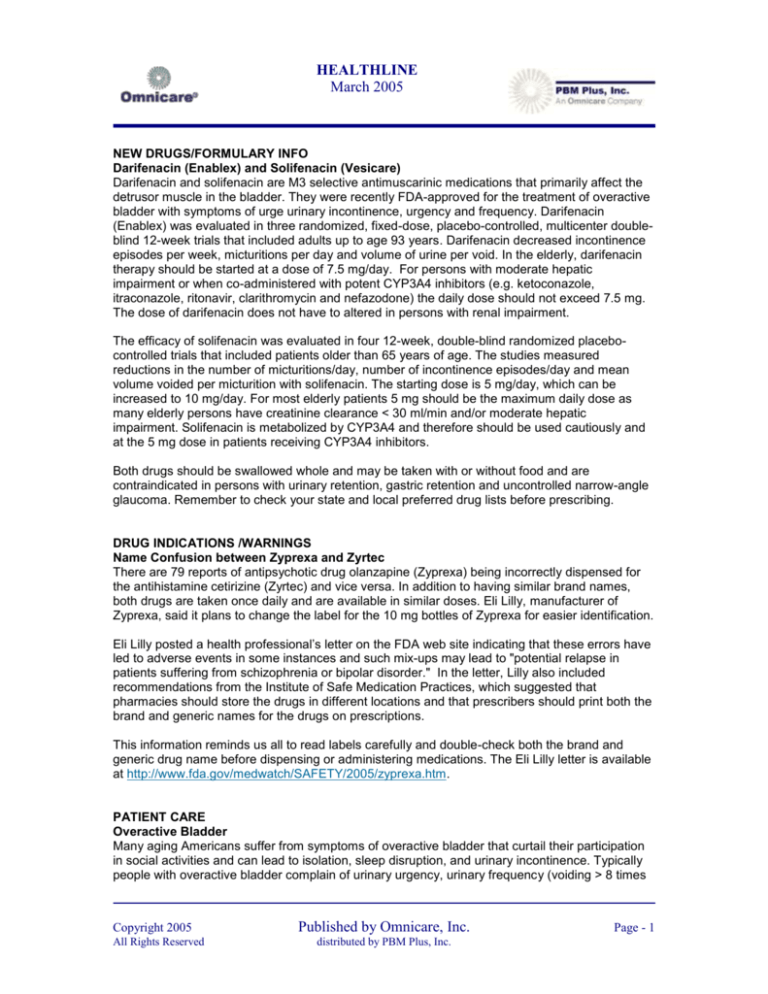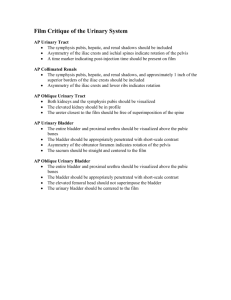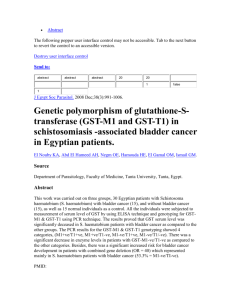
HEALTHLINE
March 2005
NEW DRUGS/FORMULARY INFO
Darifenacin (Enablex) and Solifenacin (Vesicare)
Darifenacin and solifenacin are M3 selective antimuscarinic medications that primarily affect the
detrusor muscle in the bladder. They were recently FDA-approved for the treatment of overactive
bladder with symptoms of urge urinary incontinence, urgency and frequency. Darifenacin
(Enablex) was evaluated in three randomized, fixed-dose, placebo-controlled, multicenter doubleblind 12-week trials that included adults up to age 93 years. Darifenacin decreased incontinence
episodes per week, micturitions per day and volume of urine per void. In the elderly, darifenacin
therapy should be started at a dose of 7.5 mg/day. For persons with moderate hepatic
impairment or when co-administered with potent CYP3A4 inhibitors (e.g. ketoconazole,
itraconazole, ritonavir, clarithromycin and nefazodone) the daily dose should not exceed 7.5 mg.
The dose of darifenacin does not have to altered in persons with renal impairment.
The efficacy of solifenacin was evaluated in four 12-week, double-blind randomized placebocontrolled trials that included patients older than 65 years of age. The studies measured
reductions in the number of micturitions/day, number of incontinence episodes/day and mean
volume voided per micturition with solifenacin. The starting dose is 5 mg/day, which can be
increased to 10 mg/day. For most elderly patients 5 mg should be the maximum daily dose as
many elderly persons have creatinine clearance < 30 ml/min and/or moderate hepatic
impairment. Solifenacin is metabolized by CYP3A4 and therefore should be used cautiously and
at the 5 mg dose in patients receiving CYP3A4 inhibitors.
Both drugs should be swallowed whole and may be taken with or without food and are
contraindicated in persons with urinary retention, gastric retention and uncontrolled narrow-angle
glaucoma. Remember to check your state and local preferred drug lists before prescribing.
DRUG INDICATIONS /WARNINGS
Name Confusion between Zyprexa and Zyrtec
There are 79 reports of antipsychotic drug olanzapine (Zyprexa) being incorrectly dispensed for
the antihistamine cetirizine (Zyrtec) and vice versa. In addition to having similar brand names,
both drugs are taken once daily and are available in similar doses. Eli Lilly, manufacturer of
Zyprexa, said it plans to change the label for the 10 mg bottles of Zyprexa for easier identification.
Eli Lilly posted a health professional’s letter on the FDA web site indicating that these errors have
led to adverse events in some instances and such mix-ups may lead to "potential relapse in
patients suffering from schizophrenia or bipolar disorder." In the letter, Lilly also included
recommendations from the Institute of Safe Medication Practices, which suggested that
pharmacies should store the drugs in different locations and that prescribers should print both the
brand and generic names for the drugs on prescriptions.
This information reminds us all to read labels carefully and double-check both the brand and
generic drug name before dispensing or administering medications. The Eli Lilly letter is available
at http://www.fda.gov/medwatch/SAFETY/2005/zyprexa.htm.
PATIENT CARE
Overactive Bladder
Many aging Americans suffer from symptoms of overactive bladder that curtail their participation
in social activities and can lead to isolation, sleep disruption, and urinary incontinence. Typically
people with overactive bladder complain of urinary urgency, urinary frequency (voiding > 8 times
Copyright 2005
All Rights Reserved
Published by Omnicare, Inc.
distributed by PBM Plus, Inc.
Page - 1
HEALTHLINE
March 2005
in a 24 hour period) and nocturia (awakening two or more times at night to void). The prevalence
increases with age and affects 42% of men and 31% of women aged 75 or older.
The symptoms of overactive bladder are usually associated with involuntary contraction of the
detrusor muscle. There are many conditions that contribute to symptoms of overactive bladder
including lower urinary tract infection, obstruction, and impaired bladder contractility. In women
estrogen deficiency and urinary sphincter weakness can precipitate urgency. In older men benign
or malignant prostatic enlargement can contribute to detrusor overactivity. In addition, there are a
number of neurological disorders including stroke, Alzheimer disease, multi-infarct dementia,
Parkinson’s disease, multiple sclerosis, and diabetic neuropathy that cause or worsen symptoms
of overactive bladder. Many chemicals (e.g. diuretics, caffeine, alcohol, theophylline) increase
urinary urgency and frequency making overactive bladder worse and confusing the diagnosis.
Constipation should be avoided in persons with overactive bladder to avoid straining upon
defecation.
Many non-pharmacologic/behavioral interventions that have been found to improve symptoms of
overactive bladder (such as pelvic exercises) are difficult to implement in the frail elderly.
However, we can assure that residents have good bladder and bowel habits and avoid
precipitants such as caffeine and alcohol. Table 1 lists medications that may contribute to
symptoms of overactive bladder.
Table 1: Medications That May Contribute to Symptoms of Overactive Bladder
Class of
Medication
Diuretics
Examples
Mechanism
Recommendations
Furosemide (Lasix)
Bumetanide (Bumex)
Torsemide (Demadex)
Narcotic
Analgesics
Codeine
Morphine (MS Contin,
Avinza)
Fentanyl (Duragesic)
Tramadol (Ultram)
Amitriptyline (Elavil)
Nortriptyline (Pamelor)
Desipramine
(Norpramin)
Cause a rapid increase
in bladder volume
which precipitates
urgency
Decrease bladder
contractility and may
cause urinary retention
Consider changing the
time of dose or consider
different diuretic
(thiazide) if feasible
Discontinue as soon as
possible
May cause urinary
retention and decrease
bladder contractility
Consider changing to
other antidepressants
such as escitalopram
(Lexapro) or sertraline
(Zoloft)
Discontinue as soon as
possible
Consider use of nonsedating antihistamines
if needed for pruritis or
allergic rhinitis
Discontinue as soon as
possible
Consider nonpharmacologic
intervention for insomnia
Tricyclic
antidepressants
Sedating
antihistamines
Diphendydramine
(Benadryl)
Hydroxyzine (Atarax)
Cause sedation.
May cause urinary
retention and decrease
bladder contractility
Benzodiazepines
Diazepam (Valium)
Chlordiazepoxide
(Librium)
Lorazepam (Ativan)
Alprazolam (Xanax)
Flurazepam (Dalmane)
Oxazepam (Serax)
Cause sedation.
May cause urinary
retention and decrease
bladder contractility
Copyright 2005
All Rights Reserved
Published by Omnicare, Inc.
distributed by PBM Plus, Inc.
Page - 2
HEALTHLINE
March 2005
Drug Therapy Treatment of Overactive Bladder
Many classes of medication have been studied for the treatment of symptoms of overactive
bladder. However, pitfalls limit the quality of existing studies in this area. Table 2 lists drugs with
proven clinical evidence. Other agents (hyoscyamine, propantheline, vaginal estrogen
preparations, and imipramine (Tofranil) lack scientific support and are not recommended for
treatment of overactive bladder in the elderly. Alpha-adrenergic blockers such as alfuzosin
(Uroxatral) and tamsulosin (Flomax) are indicated for benign prostatic hyperplasia and may help
symptoms such as frequency and urinary retention in men with overactive bladder.
Table 2: Recommended Drugs with Proven Efficacy in the Treatment of Overactive Bladder
Antimuscarinic Medication
Oxybutynin long-acting
(Ditropan XL)
Usual Adult Dose
5 – 30 mg daily orally
3.9 mg over a 96-hr period
(transdermal)
Tolterodine long-acting
(Detrol LA, Oxytrol)
Trospium (Sanctura)
4 mg daily orally
Solifenacin (Vesicare)
5 – 10 mg daily orally
Darifenacin (Enablex)
7.5 – 15 mg daily orally
20 mg twice daily orally
Comments
Avoid short-acting oxybutynin due to
side effects.
Transdermal patch can cause
irritation
Avoid short-acting tolterodine due to
side effects
Purported to have fewer CNS effects
than other antimuscarinics; but not
shown in clinical studies
Dosing reduction needed in renal
and hepatic impairment. Potential for
significant drug interactions.
Dosing reduction needed in hepatic
impairment. Potential for significant
drug interactions.
Well-conducted studies comparing long-acting forms oxybutynin (Ditropan XL) and tolterodine
(Detrol LA) have shown that the drugs have similar efficacy and effectiveness alone and when
combined with various types of behavioral intervention. Long-acting forms of oxybutynin and
tolterodine are equal in efficacy and effectiveness to short-acting forms of the drugs but have the
advantage of producing fewer CNS and cardiovascular side effects.
Trospium (Sanctura) has been compared to short-acting oxybutynin and found to have fewer side
effects. However, trospium has not been compared to long-acting forms of antimuscarinic
medications. Despite the fact that trospium is a quaternary ammonium compound and should
NOT cross the blood-brain barrier, the drug exhibits some CNS side effects and may not offer an
advantage over long-acting forms of oxybutynin or tolterodine.
Darifenacin (Enablex) and solifenacin (Vesicare) are antimuscarinic drugs with selective M3receptor antagonist actions and theoretically fewer anticholinergic side effects than other
antimuscarinic drugs. However, the theory has not been tested in clinical trials. No conclusions
can be drawn about the relative safety of these newer agents compared to Detrol LA or Ditropan
XL.
Clinical Effects of Antimuscarinic Medications
Clinically significant improvement in symptoms of overactive bladder is defined as a reduction in
incontinence episodes by more than 50%. Many studies look at other endpoints as well, including
reduction of urinary frequency (i.e. voids/day) and reduction of nocturia. However, unless
Copyright 2005
All Rights Reserved
Published by Omnicare, Inc.
distributed by PBM Plus, Inc.
Page - 3
HEALTHLINE
March 2005
incontinence episodes can be reduced, the clinical value of treatment is difficult to justify given
the inherent adverse effect profile of antimuscarinic medications.
When used in therapeutic doses antimuscarinic medications have been shown to reduce
nocturnal awakenings, incontinence episodes, micturition frequency, urge frequency and urge
severity. Pharmacologic treatment improves symptoms but does not eradicate the problem.
Adverse Effects
All antimuscarinic medications have some degree of anticholinergic side effects. Although dry
mouth is the most common, constipation, gastroesophageal reflux, blurred vision, urinary
retention, and cognitive side effects can also occur. Since various forms of dementia are
routinely treated with cholinesterase inhibitors (Donepezil (Aricept), Rivastigmine (Exelon), or
Galantamine (Reminyl)) in our population, the concern about adverse cognitive effects and
delirium due to antimuscarinic drugs is significant. Data suggest that oxybutynin has more central
nervous system effects than tolterodine or trospium. Many of the systemic anticholinergic side
effects are reduced with the use of long-acting formulations of these medications. However, all
elderly persons treated with antimuscarinic medications should be monitored for anticholinergic
side effects, as well as drug interactions.
Central anticholinergic side effects are believed to be mediated by M1 muscarinic receptors.
Tolterodine and oxybuytinin are non-selective antimuscarinic agents that antagonize M1, M2
(cardiovascular) and M3 (detrusor muscle) receptors. Darifenacin (Enablex) and solifenacin
(Vesicare) are selective M3 muscarinic receptor antagonists that have been shown to cause
central nervous system effects similar to placebo, however these newer drugs have not been
compared to long acting oxybutynin and tolterodine in clinical trials. All older persons receiving
medications with antimuscarinic (anticholinergic) properties should be evaluated on an ongoing
basis for changes in cognitive function including confusion due to delirium.
Summary
It has been estimated that 33 million Americans experience the symptoms of overactive bladder.
There are new treatments that look promising in the management of symptoms in elderly persons
but head-to-head clinical trials are needed to conclude that they have superior efficacy or safety
over existing therapy.
Abrams P, Cardozo L, Fall M, et al. The standardisation of terminology in lower urinary tract function: Report from the
standarisation sub-committee of the international continence society. Urology 2003:61;37-49.
Ouslander JG. Management of overactive bladder. N Engl J Med 2004;350:786-799.
Tune LE. Anticholinergic effects of medication in elderly patients. J Clin Psychiatry 2001;62(Suppl 21):11-14
Editorial Board
Karen Burton, R. Ph., GCP, FASCP
Mark Coggins, Pharm. D., GCP, FASCP
Kelly Hollenack, Pharm. D. CGP
Philip King, Pharm. D., GCP, FASCP
Susan Kleim, B.S., Pharm., GCP, FASCP
Terry O’Shea, Pharm. D., GCP, FASCP
Elmer Schmidt, Pharm. D., GCP, FASCP
Barbara J. Zarowitz, Pharm. D., GCP, FASCP
Copyright 2005
All Rights Reserved
Published by Omnicare, Inc.
distributed by PBM Plus, Inc.
Page - 4









